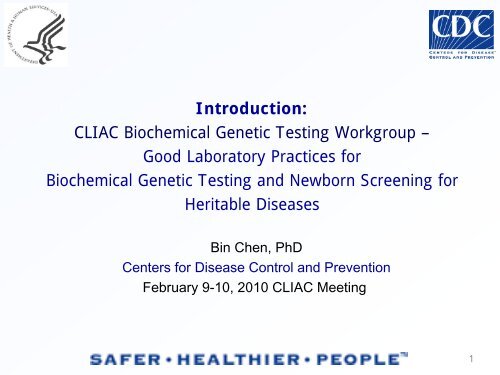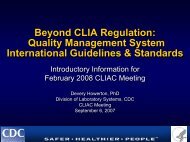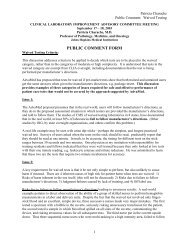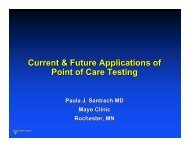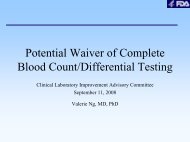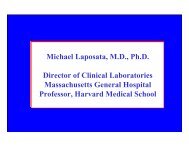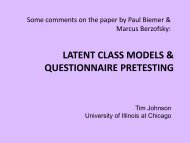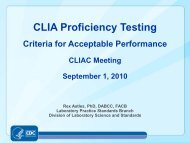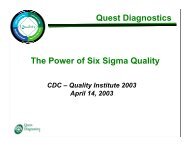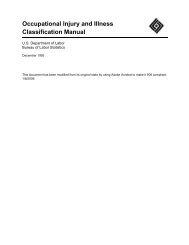Addendum J.pdf - Centers for Disease Control and Prevention
Addendum J.pdf - Centers for Disease Control and Prevention
Addendum J.pdf - Centers for Disease Control and Prevention
You also want an ePaper? Increase the reach of your titles
YUMPU automatically turns print PDFs into web optimized ePapers that Google loves.
Introduction:CLIAC Biochemical Genetic Testing Workgroup –Good Laboratory Practices <strong>for</strong>Biochemical Genetic Testing <strong>and</strong> Newborn Screening <strong>for</strong>Heritable <strong>Disease</strong>sBin Chen, PhD<strong>Centers</strong> <strong>for</strong> <strong>Disease</strong> <strong>Control</strong> <strong>and</strong> <strong>Prevention</strong>February 9-10, 2010 CLIAC Meeting1
Background-Current Oversight <strong>for</strong> Genetic Testing CLIA regulations• General requirements <strong>for</strong> non-waived testing as applicable• Specialty of clinical cytogeneticso Specific QC requirementso Qualification requirements <strong>for</strong> technical supervisor• Requirements <strong>for</strong> molecular amplification procedures FDA requirements <strong>for</strong> IVD products State requirements (e.g., New York <strong>and</strong> Washingtonstate programs) Voluntary professional practice <strong>and</strong> accreditationguidelines (e.g., ACMG, CAP, CLSI) Good laboratory practices
Background-Addressing Biochemical Genetic Testing 2007: CMS action plan to enhance oversight of genetic testing• Providing guidance rather than prescriptive regulations• Training, education, data collection, collaboration Sept. 2007: CLIAC reviewed quality assurance (QA) concerns ingenetic testing; suggested developing document to clarify CLIA<strong>and</strong> provide specific guidance 2008: CLIAC Genetics Workgroup 3 focused on molecular genetictesting <strong>for</strong> heritable diseases <strong>and</strong> conditions Sept. 2008: CLIAC provided good laboratory practicerecommendations <strong>for</strong> molecular genetic testing <strong>for</strong> inclusion inMMWR R&R (published June 2009); recommended <strong>for</strong>mingworkgroup on biochemical genetic testing (BGT) to considersimilar good laboratory practice issues3
CDC Assessment of BGT L<strong>and</strong>scape<strong>and</strong> QA Gaps Purposes:• Frame issues <strong>for</strong> workgroup consideration• Assess areas of expertise needed <strong>for</strong> theworkgroup• Assess in<strong>for</strong>mation needed to facilitateworkgroup’s evaluation of current st<strong>and</strong>ards,guidelines, practices• Help to gauge guidance’s utility <strong>and</strong> impact onlaboratory testing quality <strong>and</strong> public’s health4
Assessing BGT L<strong>and</strong>scape <strong>and</strong> Gaps Assessment of current BGT l<strong>and</strong>scape <strong>and</strong> trends• Definitions• Number of labs per<strong>for</strong>ming BGT• Number <strong>and</strong> type of diseases <strong>for</strong> which BGT is per<strong>for</strong>med• Test volume• Test methods <strong>and</strong> technology• Type of services• Availability of proficiency testing (PT)/external qualityassessment (EQA) programs• Growth <strong>and</strong> trends Review of available in<strong>for</strong>mation indicating QAconcerns, problems/gaps, room <strong>for</strong> improvement Collaboration with CDC Newborn Screening QualityAssurance Program (NBSQAP)5
Assessing BGT L<strong>and</strong>scape <strong>and</strong> Gaps Sources of in<strong>for</strong>mation/data identified <strong>for</strong> analysis:• Directories/databaseso GeneTestso Society <strong>for</strong> Inherited Metabolic Disorders (SIMD) directoryo National Newborn Screening <strong>and</strong> Genetics Resource Center• State laboratory/public health programs• Publications, reports• PT/EQA programs• In<strong>for</strong>mation from professional groups6
Assessing BGT L<strong>and</strong>scape What tests are considered BGT?• Critical <strong>for</strong> data collection, gap assessment, scope <strong>and</strong>applicability of recommendations to be developed• CLIA – no definition <strong>for</strong> BGT• Available definitions vary depending on purpose <strong>and</strong> contexto Consistent: analysis of human gene products,metabolites to detect inborn errors of metabolisms(IEMs), heritable genotypes or disorderso Usually have qualifiers <strong>and</strong> exclusions• Most NBS conditions are IEMs/inherited metabolic disorderso Screening tests, presumptive positives need to beconfirmed with diagnostic testingo Public health labs per<strong>for</strong>m NBS <strong>for</strong> 97% U.S. infants7
Assessing BGT L<strong>and</strong>scape Test volume• No published in<strong>for</strong>mation on current BGT volume ortrend of growth• Increased needs <strong>for</strong> definitive diagnosis ofpresumptive positives due to expansion of NBS(expert opinion)o More than 4 million infants born in U.S. each yearo 2005: 38% infants born in states requiring screening <strong>for</strong>over 21/29 core conditions recommended by ACMGo 2009: All states required at least 21; 24 states <strong>and</strong> DCscreen <strong>for</strong> all 29 disorders on recommended uni<strong>for</strong>m panel8
Assessing BGT L<strong>and</strong>scape Number of BGT laboratories• No comprehensive data• 2003: 162 BGT labs surveyed (McGovern et al, 2003)• As of April 2009:o GeneTests: 83 in U.S. <strong>and</strong> 63 <strong>for</strong>eigno SIMD directory: 99 (US <strong>and</strong> international)o CAP BGT survey: 114 participants in 2008; 93 in 2002o New York State: 12 in state <strong>and</strong> 20 out of state in 2009 46 state NBS laboratories9
Assessment of Expertise Needed <strong>for</strong>CLIAC Workgroup Diverse technology <strong>and</strong> diagnostic issues Diverse laboratory environments (e.g., large/small labs,common/rare disease testing, academic/private/public health,specialized/general labs) NBS <strong>and</strong> public health perspectives Expertise in laboratory per<strong>for</strong>mance evaluation, laboratoryinspection <strong>and</strong> accreditation Perspective of users of laboratory services (healthcare providers,patients, referring labs) <strong>and</strong> other stakeholders Regulatory (federal <strong>and</strong> state) oversight; voluntary st<strong>and</strong>ards<strong>and</strong> guidelines IVD manufacturers <strong>and</strong> industry CLIAC10
Gaps Identified/Issues Needing Guidance Comprehensive review of literature, reports,documents to identify QA issues <strong>and</strong> concerns Identified QA concerns relating to preanalytic,analytic, postanalytic phases of testing; personnel;quality management Comparison of all relevant laboratory st<strong>and</strong>ards <strong>and</strong>guidelines to assess practices/areas needingguidance or clarification• Regulatory vs. voluntary• National vs. international• BGT vs. genetic testing in general <strong>and</strong> general laboratory Provided to workgroup to initiate discussion <strong>and</strong> elicitadditional insights11
Preparation of Workgroup Resources 19 comprehensive crosswalks addressing each topic area needingguidance <strong>for</strong> good laboratory practices (see example; complete list ofdocuments reviewed <strong>for</strong> preparing crosswalks provided in h<strong>and</strong>outs)
CLIAC BGT Workgroup Process Workgroup <strong>for</strong>med: Feb. – March 2009 Orientation conference call: March 11, 2009 Atlanta meeting: June 1-2, 2009• Reviewed 19 crosswalks prepared by CDC• Developed initial input• Identified additional issues to be resolved 8 follow-up conference calls: June – Nov. 2009 Workgroup report finalized: Jan. 201013
Expected Next Steps Feb. 2010: Receive CLIAC recommendations <strong>for</strong> goodlaboratory practices <strong>for</strong> BGT <strong>and</strong> NBS <strong>for</strong> heritablediseases; initiate guideline preparation by CDC incollaboration with CMS <strong>and</strong> FDA Early 2011: Publication of guideline expected Prospective guideline will complement the publishedMMWR guideline <strong>for</strong> molecular genetic testing MGT <strong>and</strong> BGT guidelines should improve the quality oflaboratory genetic services <strong>and</strong> healthcare outcomesfrom genetic testing


